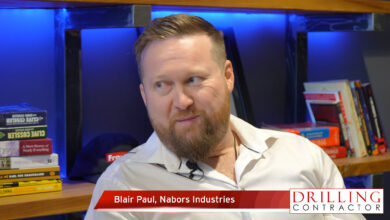Preserving our license to drill – IADC president Stephen Colville is ready to take the association to the next level
By Linda Hsieh, managing editor
Preserving the energy industry’s license to operate in an era of increasing tendency toward much tighter regulations and perhaps unnecessary overregulation is a growing challenge. For IADC, the mission is to help our members preserve the license to drill – wherever they might venture in order to access the world’s energy resources. Absent that license, the industry’s efforts to develop crew competencies and advanced technologies are for naught.

Unfortunately, opposition groups continue to elevate confusion among key stakeholders by preying on fears and doubts, and more often than we’d like, it has been an effective strategy. “Politicians and regulators are often reacting not out of the clearest and deepest of understandings of what is required to do what we do, or even how we are doing it,” said Stephen Colville, who has succeeded Dr Lee Hunt as president of IADC.
The challenge for IADC is to help its members improve environmental and safety performance and build trust through community outreach and the management of public perception. Fueling informed, logical and scientific engagement with key stakeholders helps decisions be made on clear understanding of the case rather than favoring “those shouting the loudest,” he said.
“The second part of this effort is to help raise the understanding of what our industry does,” Mr Colville continued. “We have to provide direct contexualization of what our members’ activities mean to societies and economies.”
Getting and maintaining that license will bear increasing consequence as hydrocarbon sources diversify. The emergence of unconventionals and the ultra-deepwater frontier continues to create opportunities for drilling operations and support services in new and existing energy-producing countries. IADC recognizes that it must stay relevant in this new market mix in order to continue delivering value to members, and this means matching the pace of IADC’s internationalization to that of the industry’s.
“We want to become capable of delivering the same qualitative experience and customer value everywhere in the world,” Mr Colville said. This doesn’t mean that we will needlessly duplicate everything we do currently, but it will require reinvestment into the organization to build capability and competence in different regions. “The goal is to have the membership offerings as strong elsewhere as it is in North America.”
This challenge extends not only to the geographical scale but to the time scale as well, and IADC will need to act with urgency to be effective in a fast-paced world.
“IADC has been doing a great job in meeting the needs of its members to date, but those needs are evolving at an ever-faster pace,” Mr Colville said. “We have to be quick to understand the challenges this industry is facing. That means constantly reshaping our offerings to ensure we’re delivering top value.”
During the days after Macondo, for example, IADC did not wait to respond reactively; the association and its members took immediate action through the Joint Industry Task Force to anticipate regulator concerns and thereby proactively shaped the ensuing debate. “As an organization, we must have a bias for action. IADC is not just a talking shop; we’re making things happen and delivering results,” Mr Colville said.
IADC’s key challenges: The six I’s
IADC president Stephen Colville is working to address six key challenges to ensure the association is ready for the future.
1: Internationalization. IADC must be able to operate wherever the membership has interests or seeks to grow by evolving into a diverse, multicultural organization.
2: Impact. As the membership diversifies, IADC must take a more proactive approach toward building consensus around the most effective position.
3: Inertia. Retaining current levels of engagement and empowerment with an accelerated alignment process will require reliable issue anticipation, articulation and effective coalition building.
4: Issue driven. Dealing with matters once they become critical issues makes them an order of magnitude harder to resolve. IADC must develop an effective and early issues identification capability to allow for timely responses to critical developments.
5: Ignorance. IADC must be able to develop a socially acceptable and politically viable case and communicate it constructively and effectively to diverse groups and cultures, directly and through its members and third parties, using more varied forms of media.
6: Internalization. IADC must ensure that the membership is aligned with and supportive of changes, understands the reasons for them and is aware of the additional benefits and value-adds that will accrue to them.
Diverse background
With more than three decades of combined experience in civil service, lobbying and corporate communications spanning the Americas, Europe, South Africa, Middle East, Eurasia and Asia Pacific, Mr Colville is well-equipped to lead IADC’s charge ahead.
He joined the UK Department of Industry and Trade in 1979 and spent more than a decade working in different policy divisions, including antitrust. By age 21, he was representing the UK to the European Union on quantitative restrictions on Eastern Europe.
“The civil service is amazing at development of intellectual rigor and giving you experience in building a case and representing it,” he recalled.
After 11 years, Mr Colville’s antitrust expertise led him to Advocacy Partnership, a UK-based lobbying firm. There he worked to conceive, develop and implement public and governmental affairs campaigns for large European companies, spending the bulk of his time building antitrust cases and making representations to regulatory authorities.
In 1997, he joined Chevron’s policy, government and public affairs (PGPA) division for upstream Europe. Among his projects was leading a team for the company’s reentry to Norway. This called for a branding campaign that involved routine meetings with regulatory authorities and local communities.
Mr Colville followed this experience with approximately five years in a Chevron joint venture and the Chevron global gas group, again leading efforts to communicate with governments and communities to create a better understanding of the company’s operations.
In late 2006, Mr Colville joined Shell as vice president of communications for the gas and power business. Most recently he served as VP of communications for the projects and technology business, which encompassed drilling and HSE.
“Joining IADC is allowing me to draw on all of these experiences, including delivering strategic campaigns for reputation management,” Mr Colville said.
“The more I am learning about IADC – how good it is at what it does and what it could do even more – I know taking on this leadership role is a fit with me. And I don’t mean just in terms of skills and experience but in terms of who I am, the kind of drive and determination I have, and my desire to make a positive difference.”
IADC’s core: The five C’s
Mr Colville wants to help not only our members but also IADC itself realize these core strengths:
1: Competence: The ability and skills to do what IADC and our members need to do.
2: Capability: Do we have the power and ability to do what we need to do? Do we have the freedom to work in existing geographies and grow into new ones?
3: Capacity: Extending the range and totality of what we can do will allow members to access new reserves and develop new technologies. IADC must think about new services it can provide to add value.
4: Connection: Improving the links between IADC and our members, among the members themselves and with third-party stakeholders. IADC has a critical role as a facilitator of conversations.
5: Compliance: Securing cooperation and compliance toward implementing sensible regulation and legislation.
Opportunities, strategies for growth
Mr Colville acknowledges that he faces a steep learning curve when it comes to leading the drilling industry through a membership association, but he’s eager to engage with IADC leaders and members and embark on a strategic review for growth. From that review, he will work with the association’s executive leadership to build a five-year strategic plan that sets the overarching goal and direction for the organization, underpinned by a three-year tactical rolling plan to help IADC achieve key goals along the way.
“IADC should be a campaigning organization with that bias for action I mentioned earlier, and out of the strategic plan will come clear campaign themes into which we can allocate our resources,” he described. Each campaign theme will support the goal to enhance our value proposition to members.
As an example, one vision for IADC he hopes to achieve is to create more personal touch points back to the association in members’ daily working lives, whether through training, safety, committees or other initiatives. “I want to make sure this organization is built into what our members do and how they do it, not bolted on. I want members to be able to think of us as ‘My IADC.’ ”
Part of this effort will include doing more to serve the individual members in their careers and their work in the industry, in addition to serving members as corporate organizations.
“There are lots of really interesting ideas we’ve got bubbling here,” he commented, but quickly adds that none of this should be interpreted to mean he’s out to reinvent the wheel.
In fact, Mr Colville stresses that he understands what a great organization he is taking over, that it’s highly regarded by the members, and that he will have to take responsibility and accountability as president. In short, he is after evolution, not revolution.
“We have to emphasize how we will carry on with the good things that we’re doing – advancing drilling technology, improving HSE performance and championing sensible regulations. Those things are the essence of who we are,” he said.
“Even as we welcome change, we will need to be mindful of preserving and growing the strengths that have allowed IADC to be such an effective advocate in the past.”
Onward to the future
Personally for Mr Colville, joining IADC signifies a commitment to what he believes is an organization making valuable contributions to efforts that are truly meaningful in a world dependent on fossil energy. “What we’re trying to do at IADC is about as meaningful and important as you can get, and we’re making a huge positive difference. This is a body of energized and determined professionals committed to IADC and what it’s trying to achieve. Working with people like that is just fantastic.”
He also acknowledges that stepping in as president after more than 20 years of leadership under Dr Hunt means he has a lot of catching up to do, and fast.
“The IADC leadership has confidence that I can do it, and I have confidence that I can,” Mr Colville said. “I know what a huge responsibility and honor it is to take on IADC in this role. I am honored and delighted to be handed the baton of responsibility for driving the future development of the IADC towards enabling our members to meet the growing challenges facing the drilling industry.”




